Case Study Analysis: 27 Patients, Diagnoses, & Nursing Care
VerifiedAdded on 2020/07/22
|25
|3361
|309
Case Study
AI Summary
This case study presents a detailed analysis of 27 patients, covering a wide range of medical conditions. The study begins by outlining the pathophysiology of each primary diagnosis, including conditions like THR dislocation, pneumonia, COPD, diabetic ketoacidosis, and more. It then delves into the interventions and assessment strategies for each patient, such as surgery, medication, and physical therapy. The document also provides the specific diagnoses for each patient, followed by the types of medications prescribed, including antibiotics, insulin, and antidepressants. Furthermore, the study details the essential nursing care that should be provided when administering these medications, such as dosage, frequency, and monitoring parameters. Finally, it identifies the most relevant complications associated with each diagnosis, providing a comprehensive overview of patient management and care.
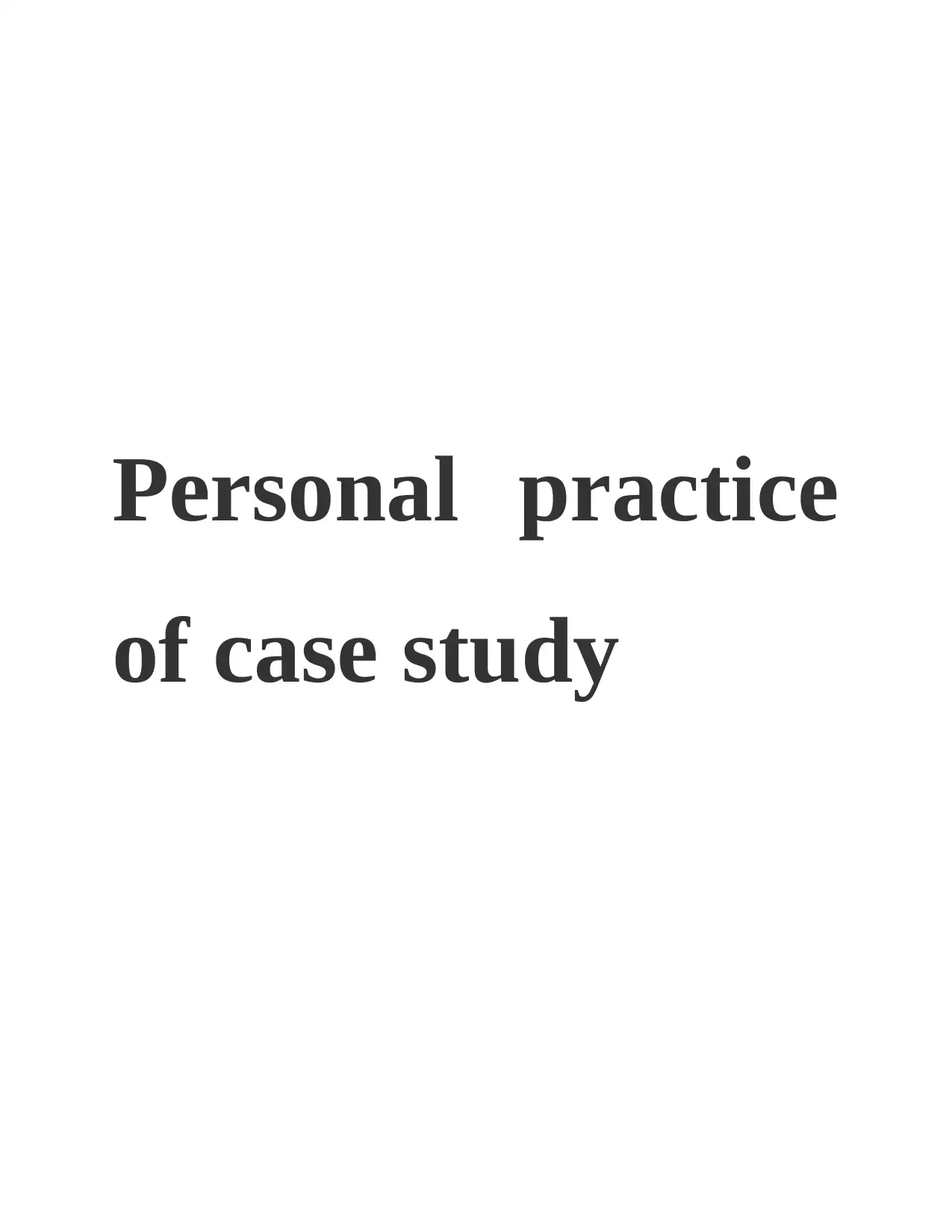
Personal practice
of case study
of case study
Paraphrase This Document
Need a fresh take? Get an instant paraphrase of this document with our AI Paraphraser
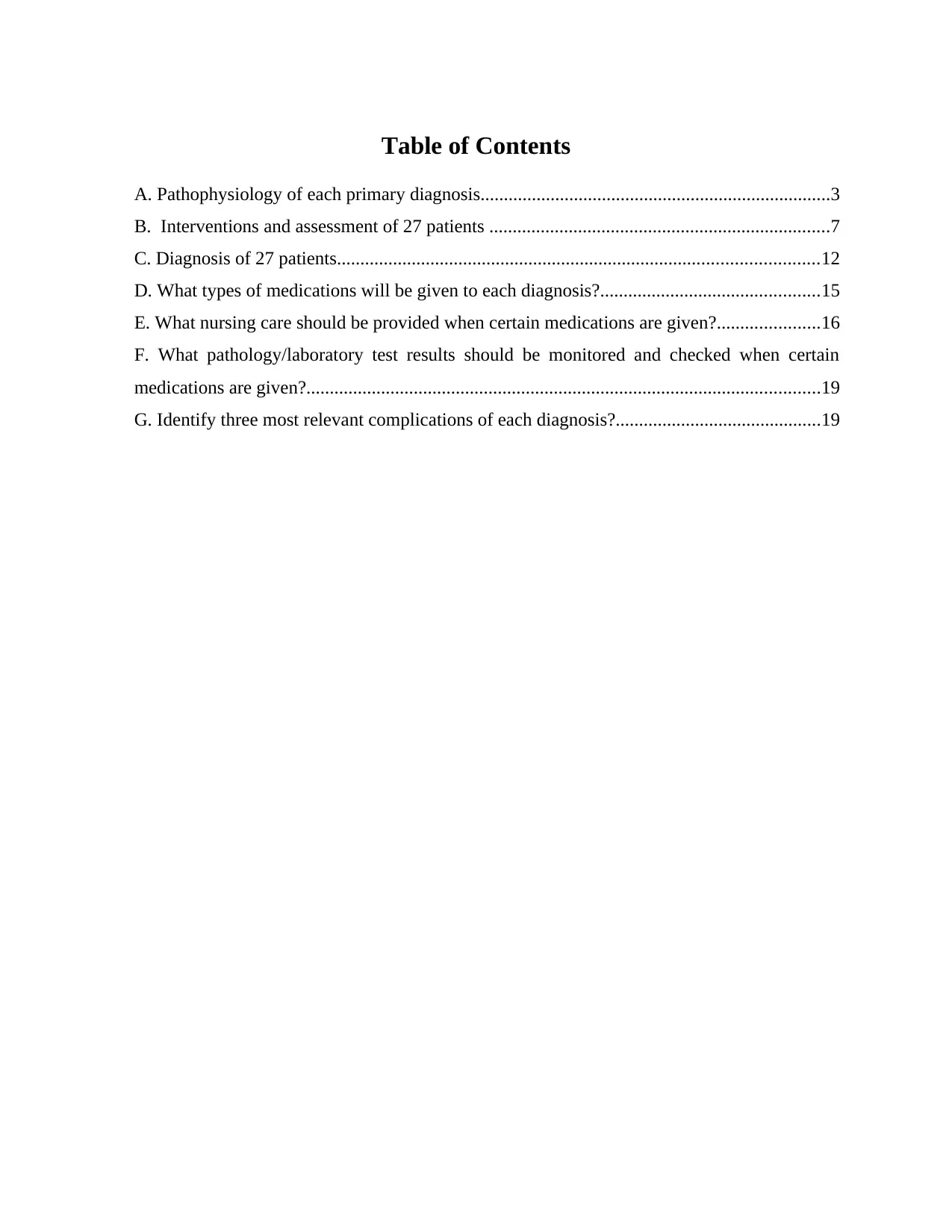
Table of Contents
A. Pathophysiology of each primary diagnosis...........................................................................3
B. Interventions and assessment of 27 patients .........................................................................7
C. Diagnosis of 27 patients.......................................................................................................12
D. What types of medications will be given to each diagnosis?...............................................15
E. What nursing care should be provided when certain medications are given?......................16
F. What pathology/laboratory test results should be monitored and checked when certain
medications are given?..............................................................................................................19
G. Identify three most relevant complications of each diagnosis?............................................19
A. Pathophysiology of each primary diagnosis...........................................................................3
B. Interventions and assessment of 27 patients .........................................................................7
C. Diagnosis of 27 patients.......................................................................................................12
D. What types of medications will be given to each diagnosis?...............................................15
E. What nursing care should be provided when certain medications are given?......................16
F. What pathology/laboratory test results should be monitored and checked when certain
medications are given?..............................................................................................................19
G. Identify three most relevant complications of each diagnosis?............................................19
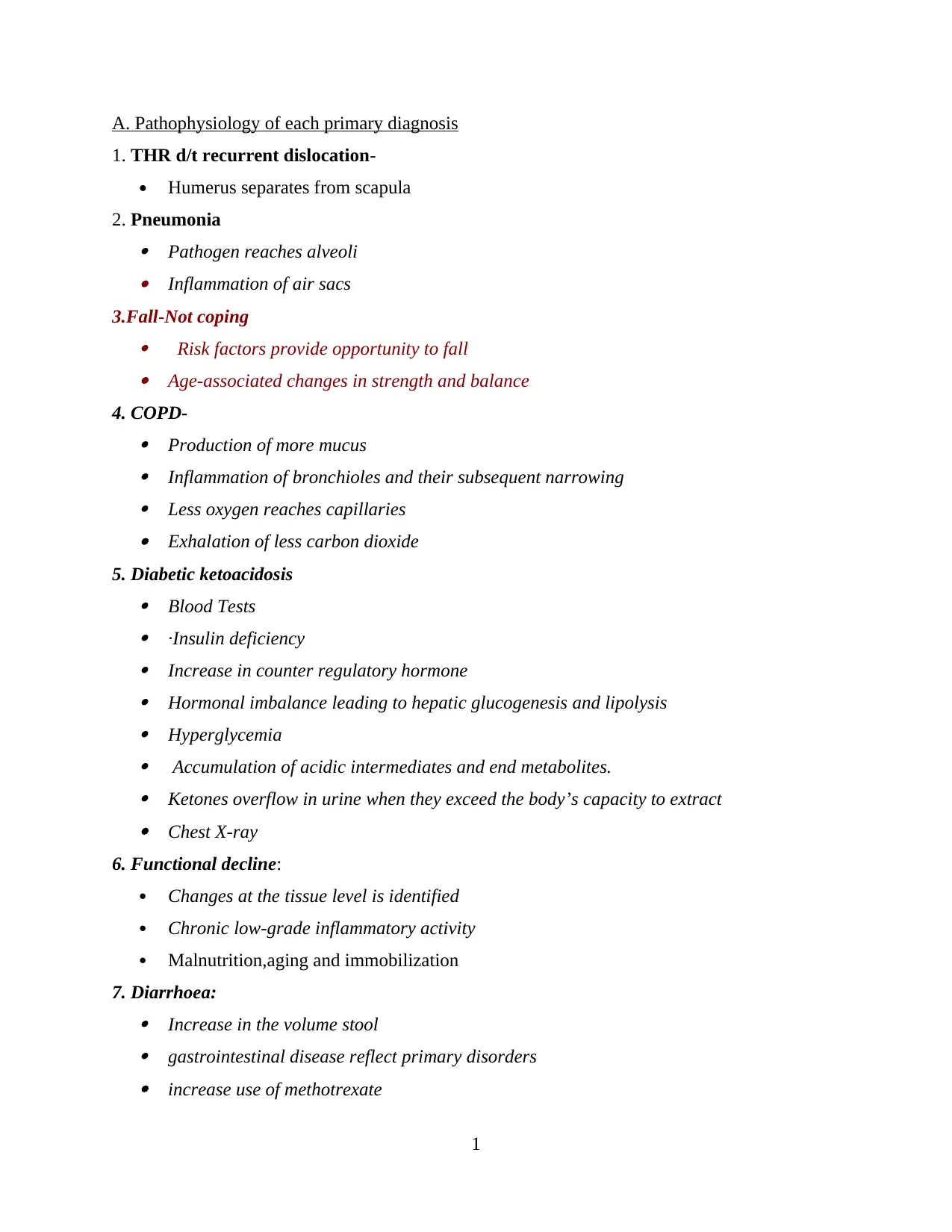
A. Pathophysiology of each primary diagnosis
1. THR d/t recurrent dislocation-
Humerus separates from scapula
2. Pneumonia Pathogen reaches alveoli Inflammation of air sacs
3.Fall-Not coping Risk factors provide opportunity to fall Age-associated changes in strength and balance
4. COPD- Production of more mucus Inflammation of bronchioles and their subsequent narrowing Less oxygen reaches capillaries Exhalation of less carbon dioxide
5. Diabetic ketoacidosis Blood Tests ·Insulin deficiency Increase in counter regulatory hormone Hormonal imbalance leading to hepatic glucogenesis and lipolysis Hyperglycemia Accumulation of acidic intermediates and end metabolites. Ketones overflow in urine when they exceed the body’s capacity to extract Chest X-ray
6. Functional decline:
Changes at the tissue level is identified
Chronic low-grade inflammatory activity
Malnutrition,aging and immobilization
7. Diarrhoea: Increase in the volume stool gastrointestinal disease reflect primary disorders increase use of methotrexate
1
1. THR d/t recurrent dislocation-
Humerus separates from scapula
2. Pneumonia Pathogen reaches alveoli Inflammation of air sacs
3.Fall-Not coping Risk factors provide opportunity to fall Age-associated changes in strength and balance
4. COPD- Production of more mucus Inflammation of bronchioles and their subsequent narrowing Less oxygen reaches capillaries Exhalation of less carbon dioxide
5. Diabetic ketoacidosis Blood Tests ·Insulin deficiency Increase in counter regulatory hormone Hormonal imbalance leading to hepatic glucogenesis and lipolysis Hyperglycemia Accumulation of acidic intermediates and end metabolites. Ketones overflow in urine when they exceed the body’s capacity to extract Chest X-ray
6. Functional decline:
Changes at the tissue level is identified
Chronic low-grade inflammatory activity
Malnutrition,aging and immobilization
7. Diarrhoea: Increase in the volume stool gastrointestinal disease reflect primary disorders increase use of methotrexate
1
⊘ This is a preview!⊘
Do you want full access?
Subscribe today to unlock all pages.

Trusted by 1+ million students worldwide
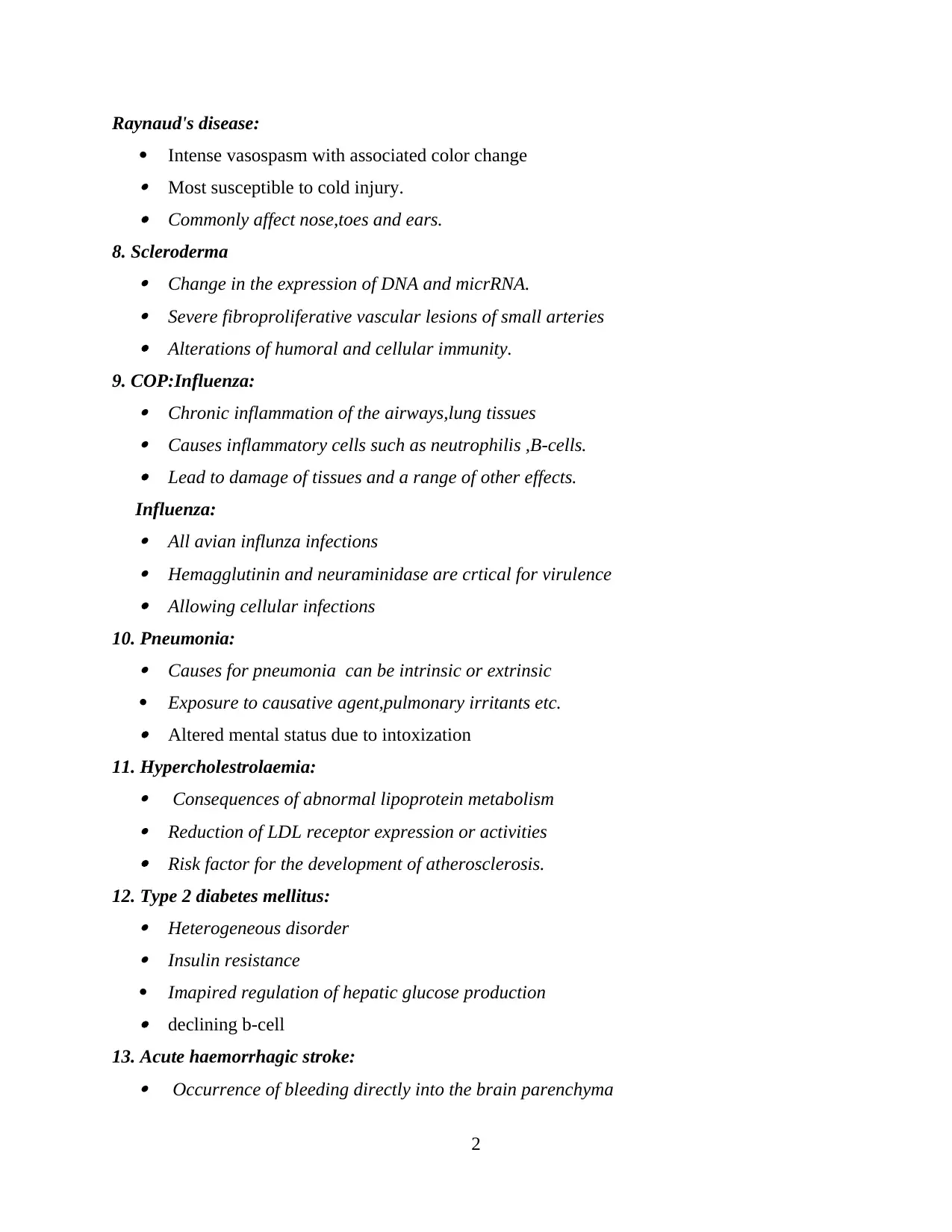
Raynaud's disease:
Intense vasospasm with associated color change Most susceptible to cold injury. Commonly affect nose,toes and ears.
8. Scleroderma Change in the expression of DNA and micrRNA. Severe fibroproliferative vascular lesions of small arteries Alterations of humoral and cellular immunity.
9. COP:Influenza: Chronic inflammation of the airways,lung tissues Causes inflammatory cells such as neutrophilis ,B-cells. Lead to damage of tissues and a range of other effects.
Influenza: All avian influnza infections Hemagglutinin and neuraminidase are crtical for virulence Allowing cellular infections
10. Pneumonia: Causes for pneumonia can be intrinsic or extrinsic
Exposure to causative agent,pulmonary irritants etc. Altered mental status due to intoxization
11. Hypercholestrolaemia: Consequences of abnormal lipoprotein metabolism Reduction of LDL receptor expression or activities Risk factor for the development of atherosclerosis.
12. Type 2 diabetes mellitus: Heterogeneous disorder Insulin resistance
Imapired regulation of hepatic glucose production declining b-cell
13. Acute haemorrhagic stroke: Occurrence of bleeding directly into the brain parenchyma
2
Intense vasospasm with associated color change Most susceptible to cold injury. Commonly affect nose,toes and ears.
8. Scleroderma Change in the expression of DNA and micrRNA. Severe fibroproliferative vascular lesions of small arteries Alterations of humoral and cellular immunity.
9. COP:Influenza: Chronic inflammation of the airways,lung tissues Causes inflammatory cells such as neutrophilis ,B-cells. Lead to damage of tissues and a range of other effects.
Influenza: All avian influnza infections Hemagglutinin and neuraminidase are crtical for virulence Allowing cellular infections
10. Pneumonia: Causes for pneumonia can be intrinsic or extrinsic
Exposure to causative agent,pulmonary irritants etc. Altered mental status due to intoxization
11. Hypercholestrolaemia: Consequences of abnormal lipoprotein metabolism Reduction of LDL receptor expression or activities Risk factor for the development of atherosclerosis.
12. Type 2 diabetes mellitus: Heterogeneous disorder Insulin resistance
Imapired regulation of hepatic glucose production declining b-cell
13. Acute haemorrhagic stroke: Occurrence of bleeding directly into the brain parenchyma
2
Paraphrase This Document
Need a fresh take? Get an instant paraphrase of this document with our AI Paraphraser
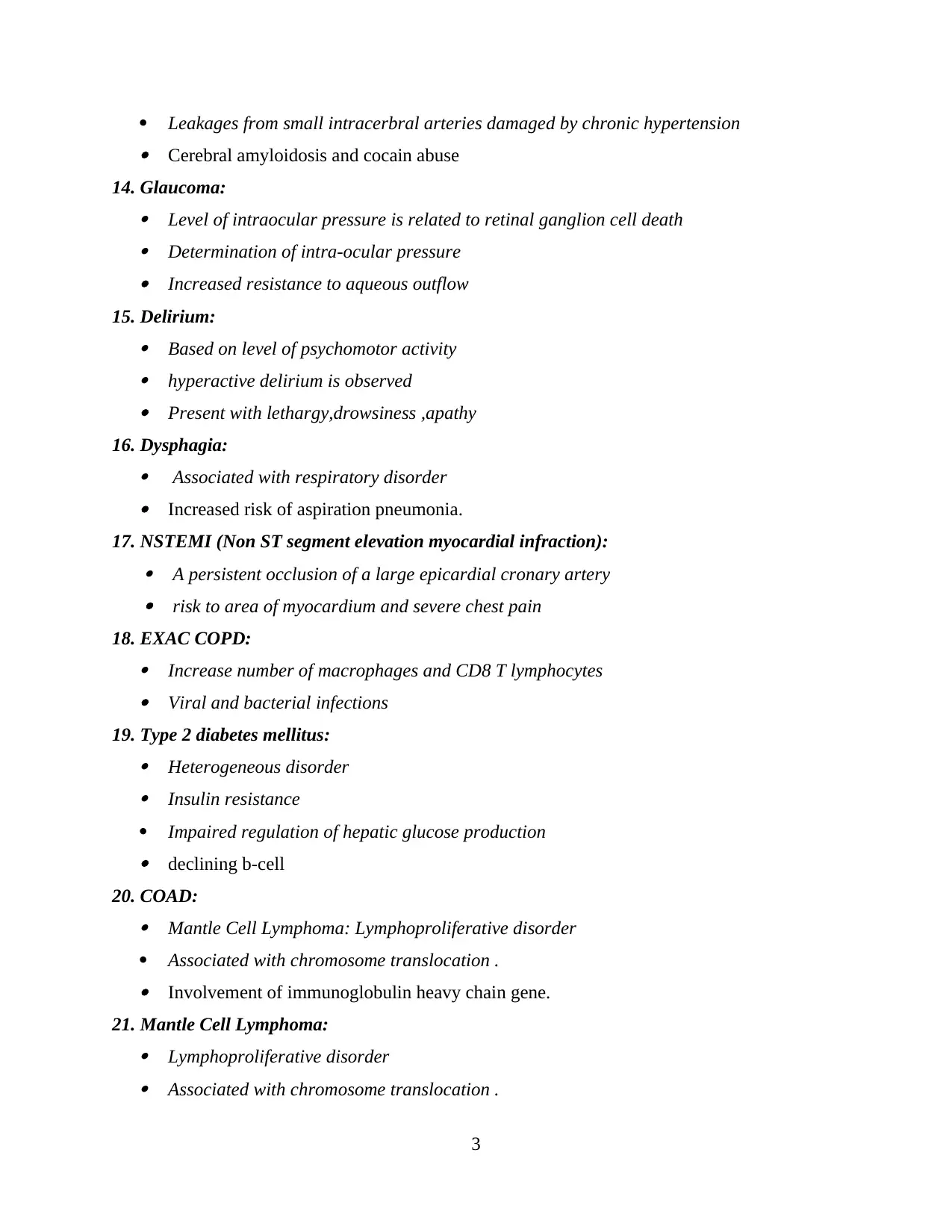
Leakages from small intracerbral arteries damaged by chronic hypertension Cerebral amyloidosis and cocain abuse
14. Glaucoma: Level of intraocular pressure is related to retinal ganglion cell death Determination of intra-ocular pressure Increased resistance to aqueous outflow
15. Delirium: Based on level of psychomotor activity hyperactive delirium is observed Present with lethargy,drowsiness ,apathy
16. Dysphagia: Associated with respiratory disorder Increased risk of aspiration pneumonia.
17. NSTEMI (Non ST segment elevation myocardial infraction): A persistent occlusion of a large epicardial cronary artery risk to area of myocardium and severe chest pain
18. EXAC COPD: Increase number of macrophages and CD8 T lymphocytes Viral and bacterial infections
19. Type 2 diabetes mellitus: Heterogeneous disorder Insulin resistance
Impaired regulation of hepatic glucose production declining b-cell
20. COAD: Mantle Cell Lymphoma: Lymphoproliferative disorder
Associated with chromosome translocation . Involvement of immunoglobulin heavy chain gene.
21. Mantle Cell Lymphoma: Lymphoproliferative disorder Associated with chromosome translocation .
3
14. Glaucoma: Level of intraocular pressure is related to retinal ganglion cell death Determination of intra-ocular pressure Increased resistance to aqueous outflow
15. Delirium: Based on level of psychomotor activity hyperactive delirium is observed Present with lethargy,drowsiness ,apathy
16. Dysphagia: Associated with respiratory disorder Increased risk of aspiration pneumonia.
17. NSTEMI (Non ST segment elevation myocardial infraction): A persistent occlusion of a large epicardial cronary artery risk to area of myocardium and severe chest pain
18. EXAC COPD: Increase number of macrophages and CD8 T lymphocytes Viral and bacterial infections
19. Type 2 diabetes mellitus: Heterogeneous disorder Insulin resistance
Impaired regulation of hepatic glucose production declining b-cell
20. COAD: Mantle Cell Lymphoma: Lymphoproliferative disorder
Associated with chromosome translocation . Involvement of immunoglobulin heavy chain gene.
21. Mantle Cell Lymphoma: Lymphoproliferative disorder Associated with chromosome translocation .
3
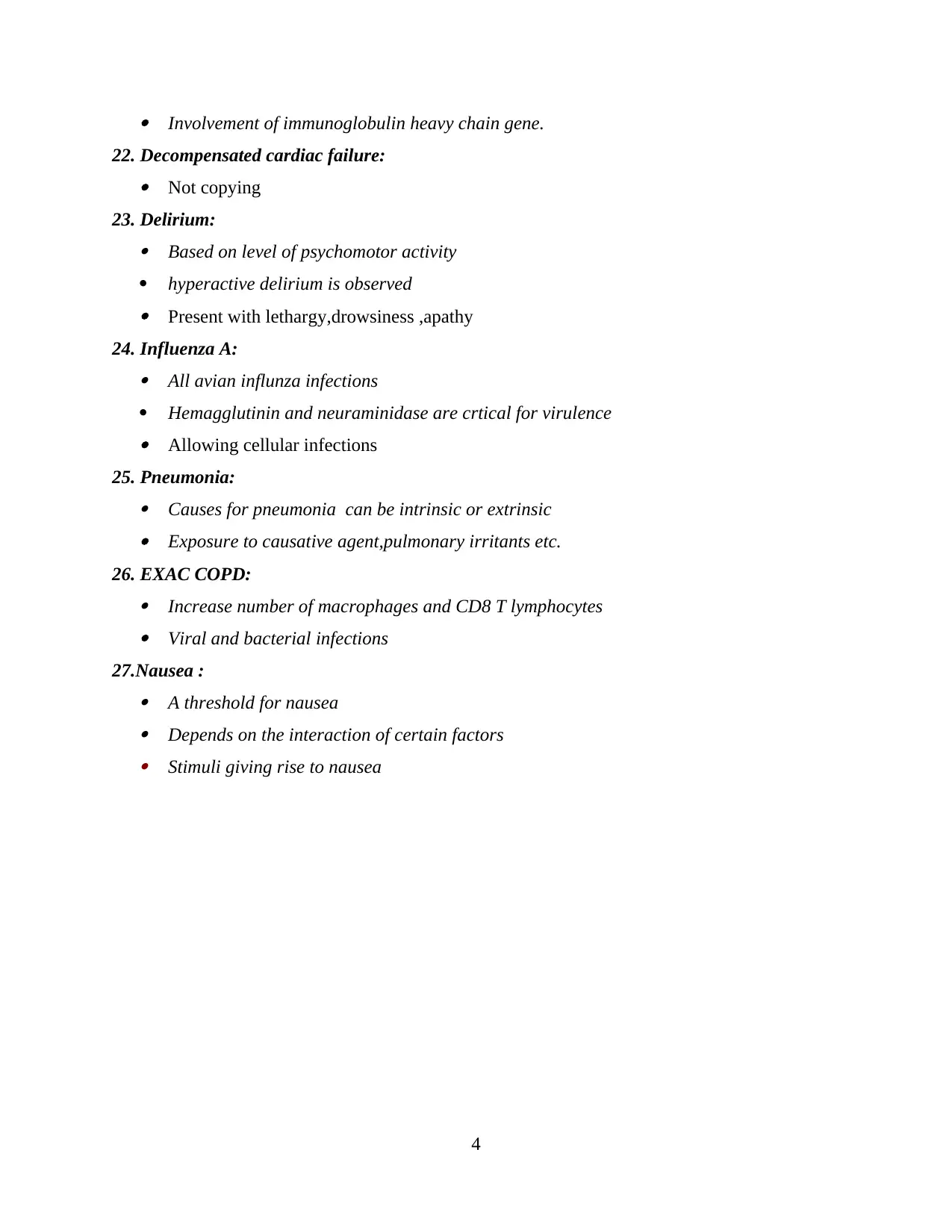
Involvement of immunoglobulin heavy chain gene.
22. Decompensated cardiac failure: Not copying
23. Delirium: Based on level of psychomotor activity
hyperactive delirium is observed Present with lethargy,drowsiness ,apathy
24. Influenza A: All avian influnza infections
Hemagglutinin and neuraminidase are crtical for virulence Allowing cellular infections
25. Pneumonia: Causes for pneumonia can be intrinsic or extrinsic Exposure to causative agent,pulmonary irritants etc.
26. EXAC COPD: Increase number of macrophages and CD8 T lymphocytes Viral and bacterial infections
27.Nausea : A threshold for nausea Depends on the interaction of certain factors Stimuli giving rise to nausea
4
22. Decompensated cardiac failure: Not copying
23. Delirium: Based on level of psychomotor activity
hyperactive delirium is observed Present with lethargy,drowsiness ,apathy
24. Influenza A: All avian influnza infections
Hemagglutinin and neuraminidase are crtical for virulence Allowing cellular infections
25. Pneumonia: Causes for pneumonia can be intrinsic or extrinsic Exposure to causative agent,pulmonary irritants etc.
26. EXAC COPD: Increase number of macrophages and CD8 T lymphocytes Viral and bacterial infections
27.Nausea : A threshold for nausea Depends on the interaction of certain factors Stimuli giving rise to nausea
4
⊘ This is a preview!⊘
Do you want full access?
Subscribe today to unlock all pages.

Trusted by 1+ million students worldwide
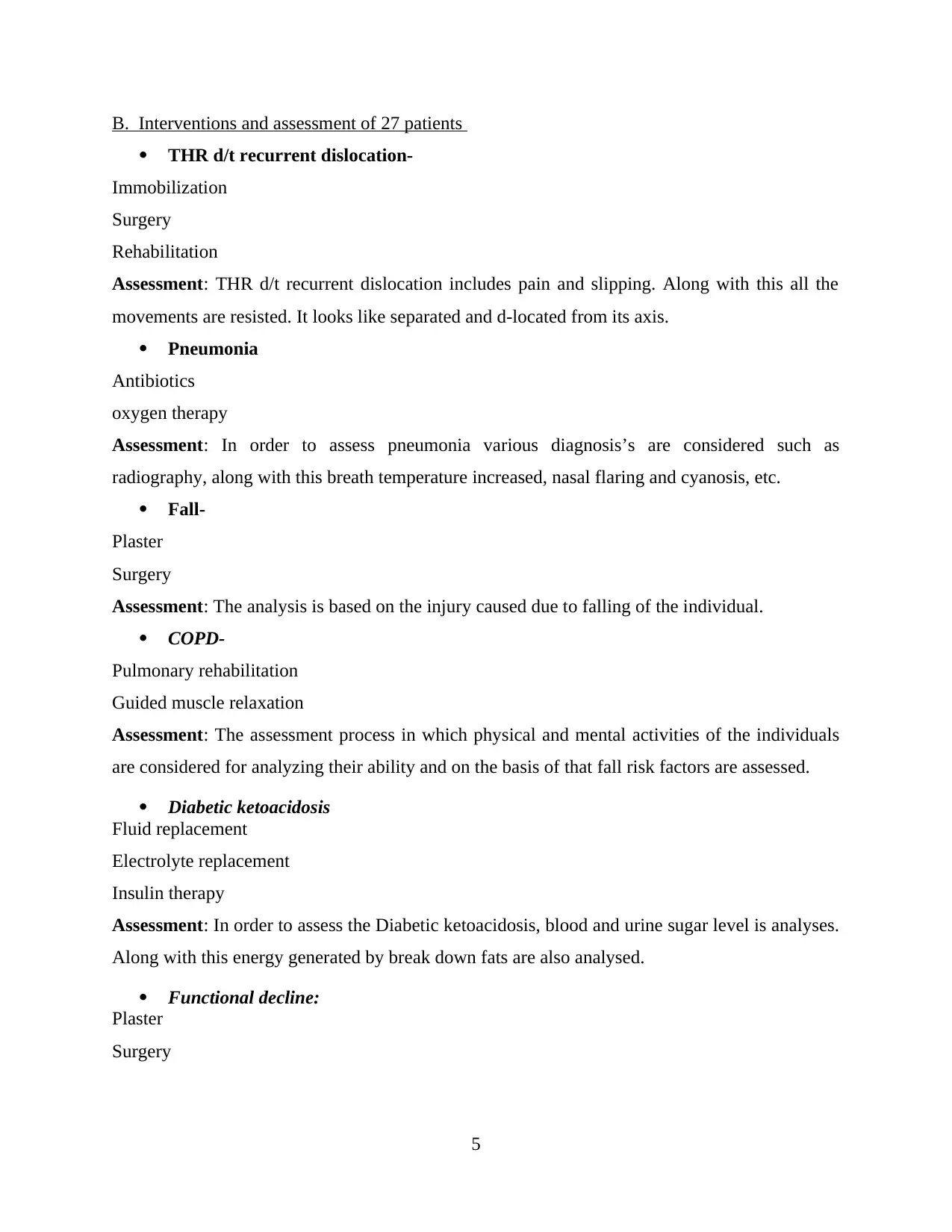
B. Interventions and assessment of 27 patients
THR d/t recurrent dislocation-
Immobilization
Surgery
Rehabilitation
Assessment: THR d/t recurrent dislocation includes pain and slipping. Along with this all the
movements are resisted. It looks like separated and d-located from its axis.
Pneumonia
Antibiotics
oxygen therapy
Assessment: In order to assess pneumonia various diagnosis’s are considered such as
radiography, along with this breath temperature increased, nasal flaring and cyanosis, etc.
Fall-
Plaster
Surgery
Assessment: The analysis is based on the injury caused due to falling of the individual.
COPD-
Pulmonary rehabilitation
Guided muscle relaxation
Assessment: The assessment process in which physical and mental activities of the individuals
are considered for analyzing their ability and on the basis of that fall risk factors are assessed.
Diabetic ketoacidosis
Fluid replacement
Electrolyte replacement
Insulin therapy
Assessment: In order to assess the Diabetic ketoacidosis, blood and urine sugar level is analyses.
Along with this energy generated by break down fats are also analysed.
Functional decline:
Plaster
Surgery
5
THR d/t recurrent dislocation-
Immobilization
Surgery
Rehabilitation
Assessment: THR d/t recurrent dislocation includes pain and slipping. Along with this all the
movements are resisted. It looks like separated and d-located from its axis.
Pneumonia
Antibiotics
oxygen therapy
Assessment: In order to assess pneumonia various diagnosis’s are considered such as
radiography, along with this breath temperature increased, nasal flaring and cyanosis, etc.
Fall-
Plaster
Surgery
Assessment: The analysis is based on the injury caused due to falling of the individual.
COPD-
Pulmonary rehabilitation
Guided muscle relaxation
Assessment: The assessment process in which physical and mental activities of the individuals
are considered for analyzing their ability and on the basis of that fall risk factors are assessed.
Diabetic ketoacidosis
Fluid replacement
Electrolyte replacement
Insulin therapy
Assessment: In order to assess the Diabetic ketoacidosis, blood and urine sugar level is analyses.
Along with this energy generated by break down fats are also analysed.
Functional decline:
Plaster
Surgery
5
Paraphrase This Document
Need a fresh take? Get an instant paraphrase of this document with our AI Paraphraser
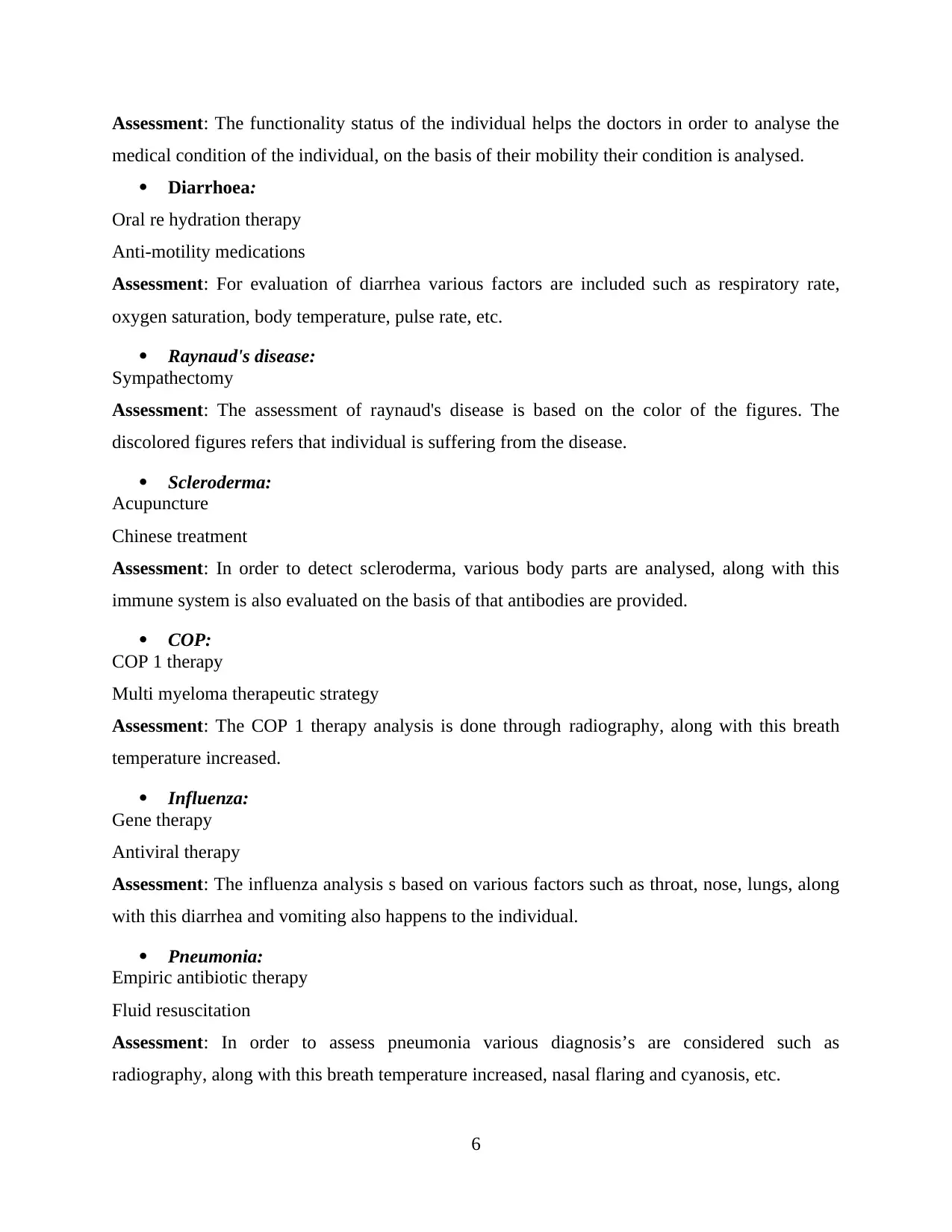
Assessment: The functionality status of the individual helps the doctors in order to analyse the
medical condition of the individual, on the basis of their mobility their condition is analysed.
Diarrhoea:
Oral re hydration therapy
Anti-motility medications
Assessment: For evaluation of diarrhea various factors are included such as respiratory rate,
oxygen saturation, body temperature, pulse rate, etc.
Raynaud's disease:
Sympathectomy
Assessment: The assessment of raynaud's disease is based on the color of the figures. The
discolored figures refers that individual is suffering from the disease.
Scleroderma:
Acupuncture
Chinese treatment
Assessment: In order to detect scleroderma, various body parts are analysed, along with this
immune system is also evaluated on the basis of that antibodies are provided.
COP:
COP 1 therapy
Multi myeloma therapeutic strategy
Assessment: The COP 1 therapy analysis is done through radiography, along with this breath
temperature increased.
Influenza:
Gene therapy
Antiviral therapy
Assessment: The influenza analysis s based on various factors such as throat, nose, lungs, along
with this diarrhea and vomiting also happens to the individual.
Pneumonia:
Empiric antibiotic therapy
Fluid resuscitation
Assessment: In order to assess pneumonia various diagnosis’s are considered such as
radiography, along with this breath temperature increased, nasal flaring and cyanosis, etc.
6
medical condition of the individual, on the basis of their mobility their condition is analysed.
Diarrhoea:
Oral re hydration therapy
Anti-motility medications
Assessment: For evaluation of diarrhea various factors are included such as respiratory rate,
oxygen saturation, body temperature, pulse rate, etc.
Raynaud's disease:
Sympathectomy
Assessment: The assessment of raynaud's disease is based on the color of the figures. The
discolored figures refers that individual is suffering from the disease.
Scleroderma:
Acupuncture
Chinese treatment
Assessment: In order to detect scleroderma, various body parts are analysed, along with this
immune system is also evaluated on the basis of that antibodies are provided.
COP:
COP 1 therapy
Multi myeloma therapeutic strategy
Assessment: The COP 1 therapy analysis is done through radiography, along with this breath
temperature increased.
Influenza:
Gene therapy
Antiviral therapy
Assessment: The influenza analysis s based on various factors such as throat, nose, lungs, along
with this diarrhea and vomiting also happens to the individual.
Pneumonia:
Empiric antibiotic therapy
Fluid resuscitation
Assessment: In order to assess pneumonia various diagnosis’s are considered such as
radiography, along with this breath temperature increased, nasal flaring and cyanosis, etc.
6
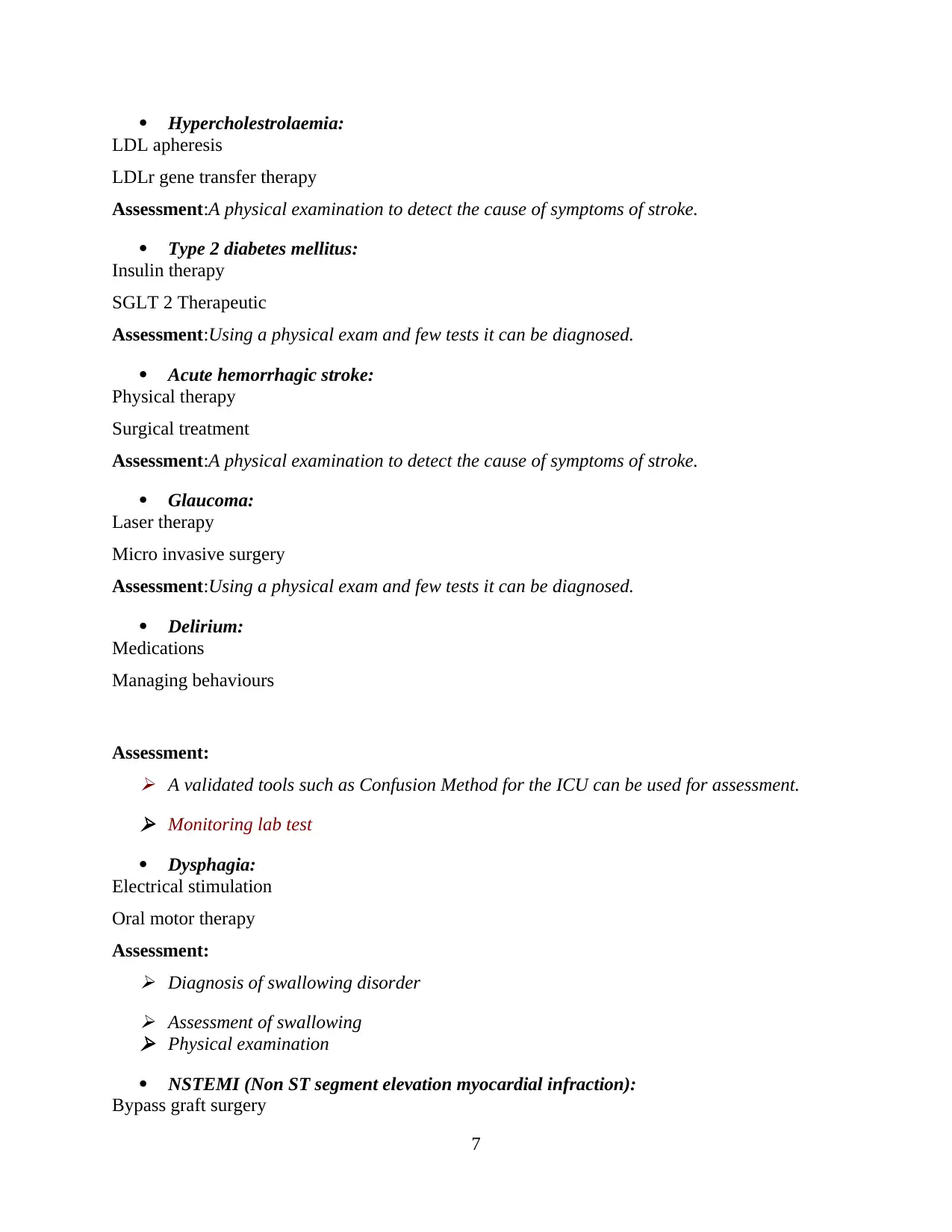
Hypercholestrolaemia:
LDL apheresis
LDLr gene transfer therapy
Assessment:A physical examination to detect the cause of symptoms of stroke.
Type 2 diabetes mellitus:
Insulin therapy
SGLT 2 Therapeutic
Assessment:Using a physical exam and few tests it can be diagnosed.
Acute hemorrhagic stroke:
Physical therapy
Surgical treatment
Assessment:A physical examination to detect the cause of symptoms of stroke.
Glaucoma:
Laser therapy
Micro invasive surgery
Assessment:Using a physical exam and few tests it can be diagnosed.
Delirium:
Medications
Managing behaviours
Assessment: A validated tools such as Confusion Method for the ICU can be used for assessment. Monitoring lab test
Dysphagia:
Electrical stimulation
Oral motor therapy
Assessment: Diagnosis of swallowing disorder Assessment of swallowing
Physical examination
NSTEMI (Non ST segment elevation myocardial infraction):
Bypass graft surgery
7
LDL apheresis
LDLr gene transfer therapy
Assessment:A physical examination to detect the cause of symptoms of stroke.
Type 2 diabetes mellitus:
Insulin therapy
SGLT 2 Therapeutic
Assessment:Using a physical exam and few tests it can be diagnosed.
Acute hemorrhagic stroke:
Physical therapy
Surgical treatment
Assessment:A physical examination to detect the cause of symptoms of stroke.
Glaucoma:
Laser therapy
Micro invasive surgery
Assessment:Using a physical exam and few tests it can be diagnosed.
Delirium:
Medications
Managing behaviours
Assessment: A validated tools such as Confusion Method for the ICU can be used for assessment. Monitoring lab test
Dysphagia:
Electrical stimulation
Oral motor therapy
Assessment: Diagnosis of swallowing disorder Assessment of swallowing
Physical examination
NSTEMI (Non ST segment elevation myocardial infraction):
Bypass graft surgery
7
⊘ This is a preview!⊘
Do you want full access?
Subscribe today to unlock all pages.

Trusted by 1+ million students worldwide
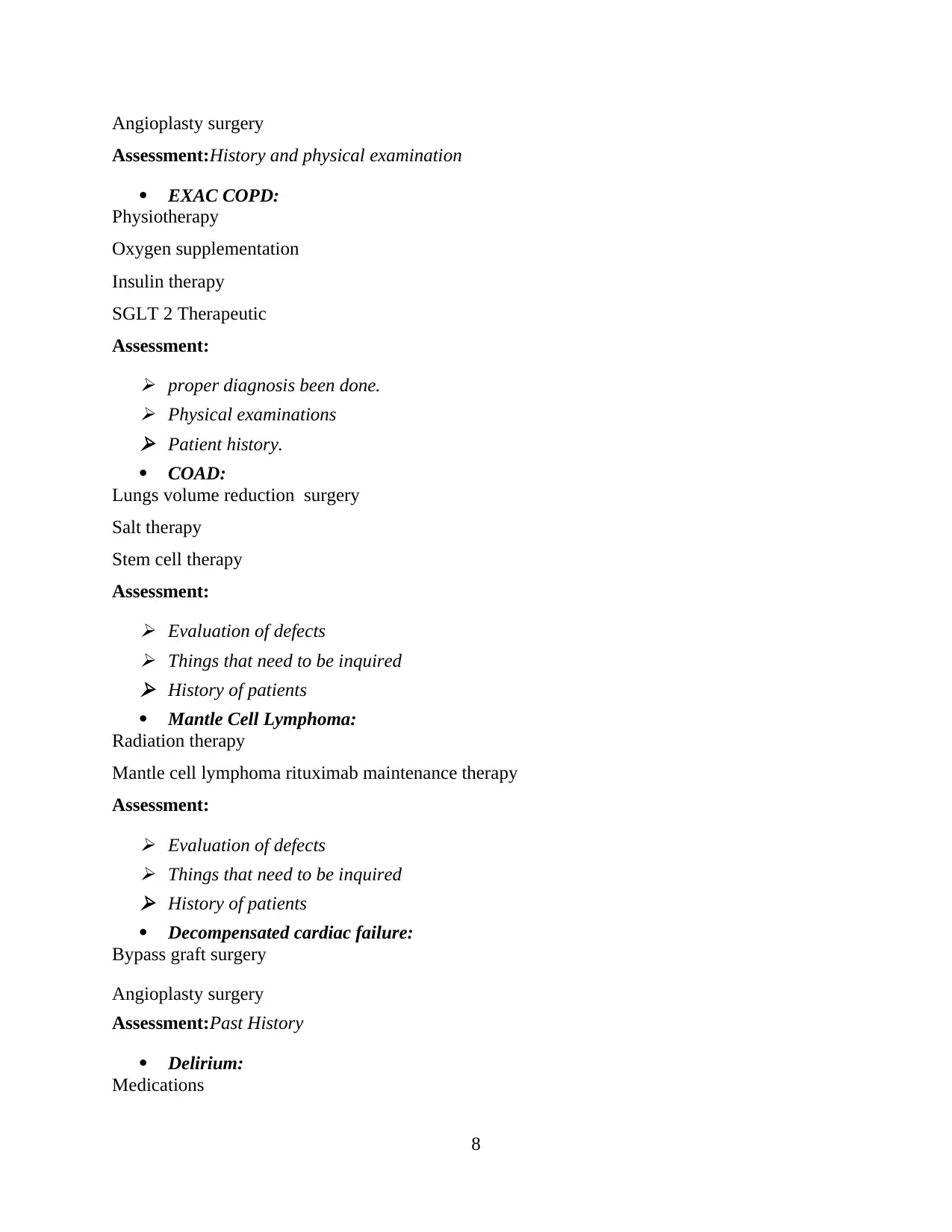
Angioplasty surgery
Assessment:History and physical examination
EXAC COPD:
Physiotherapy
Oxygen supplementation
Insulin therapy
SGLT 2 Therapeutic
Assessment: proper diagnosis been done. Physical examinations Patient history.
COAD:
Lungs volume reduction surgery
Salt therapy
Stem cell therapy
Assessment: Evaluation of defects Things that need to be inquired History of patients
Mantle Cell Lymphoma:
Radiation therapy
Mantle cell lymphoma rituximab maintenance therapy
Assessment: Evaluation of defects Things that need to be inquired History of patients
Decompensated cardiac failure:
Bypass graft surgery
Angioplasty surgery
Assessment:Past History
Delirium:
Medications
8
Assessment:History and physical examination
EXAC COPD:
Physiotherapy
Oxygen supplementation
Insulin therapy
SGLT 2 Therapeutic
Assessment: proper diagnosis been done. Physical examinations Patient history.
COAD:
Lungs volume reduction surgery
Salt therapy
Stem cell therapy
Assessment: Evaluation of defects Things that need to be inquired History of patients
Mantle Cell Lymphoma:
Radiation therapy
Mantle cell lymphoma rituximab maintenance therapy
Assessment: Evaluation of defects Things that need to be inquired History of patients
Decompensated cardiac failure:
Bypass graft surgery
Angioplasty surgery
Assessment:Past History
Delirium:
Medications
8
Paraphrase This Document
Need a fresh take? Get an instant paraphrase of this document with our AI Paraphraser
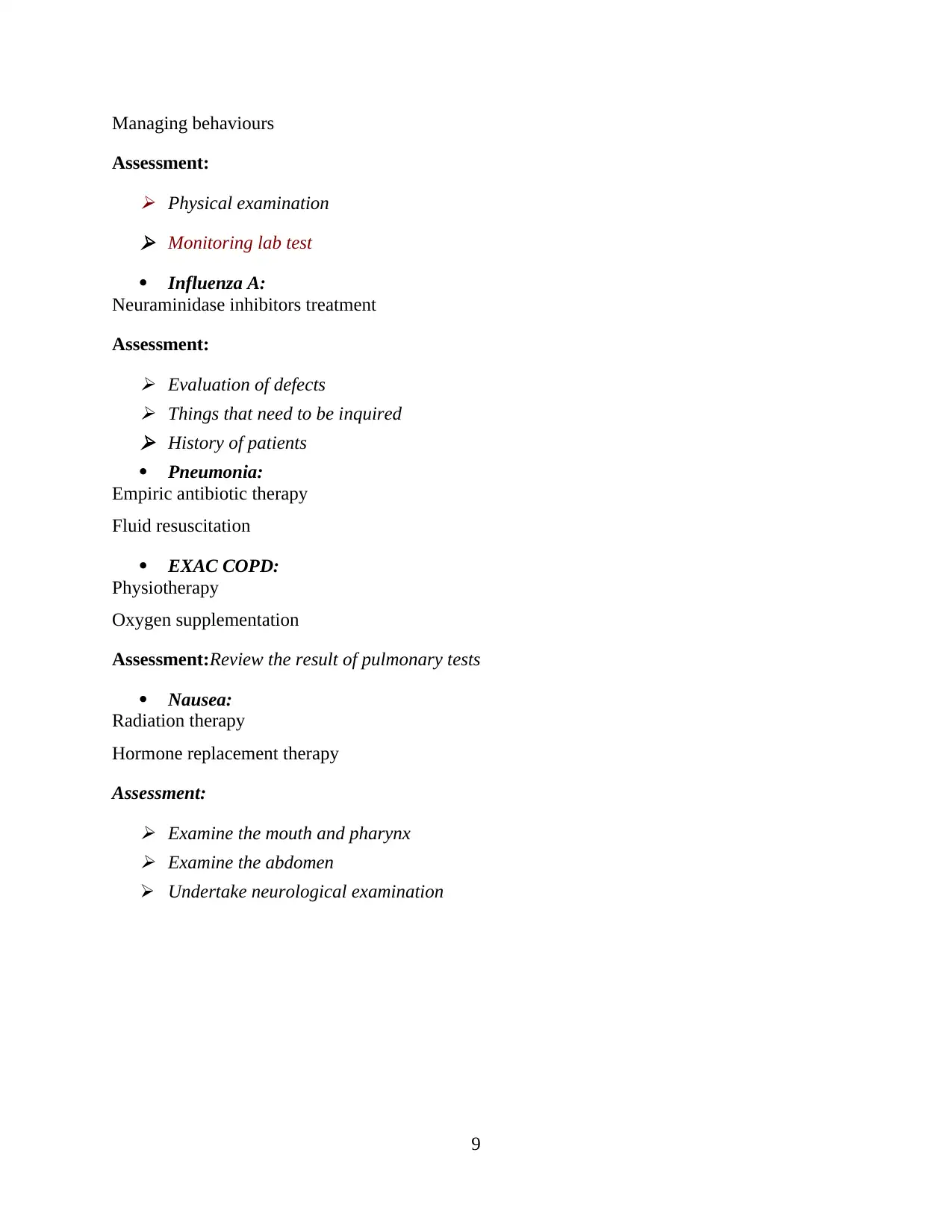
Managing behaviours
Assessment: Physical examination Monitoring lab test
Influenza A:
Neuraminidase inhibitors treatment
Assessment: Evaluation of defects Things that need to be inquired History of patients
Pneumonia:
Empiric antibiotic therapy
Fluid resuscitation
EXAC COPD:
Physiotherapy
Oxygen supplementation
Assessment:Review the result of pulmonary tests
Nausea:
Radiation therapy
Hormone replacement therapy
Assessment: Examine the mouth and pharynx Examine the abdomen
Undertake neurological examination
9
Assessment: Physical examination Monitoring lab test
Influenza A:
Neuraminidase inhibitors treatment
Assessment: Evaluation of defects Things that need to be inquired History of patients
Pneumonia:
Empiric antibiotic therapy
Fluid resuscitation
EXAC COPD:
Physiotherapy
Oxygen supplementation
Assessment:Review the result of pulmonary tests
Nausea:
Radiation therapy
Hormone replacement therapy
Assessment: Examine the mouth and pharynx Examine the abdomen
Undertake neurological examination
9
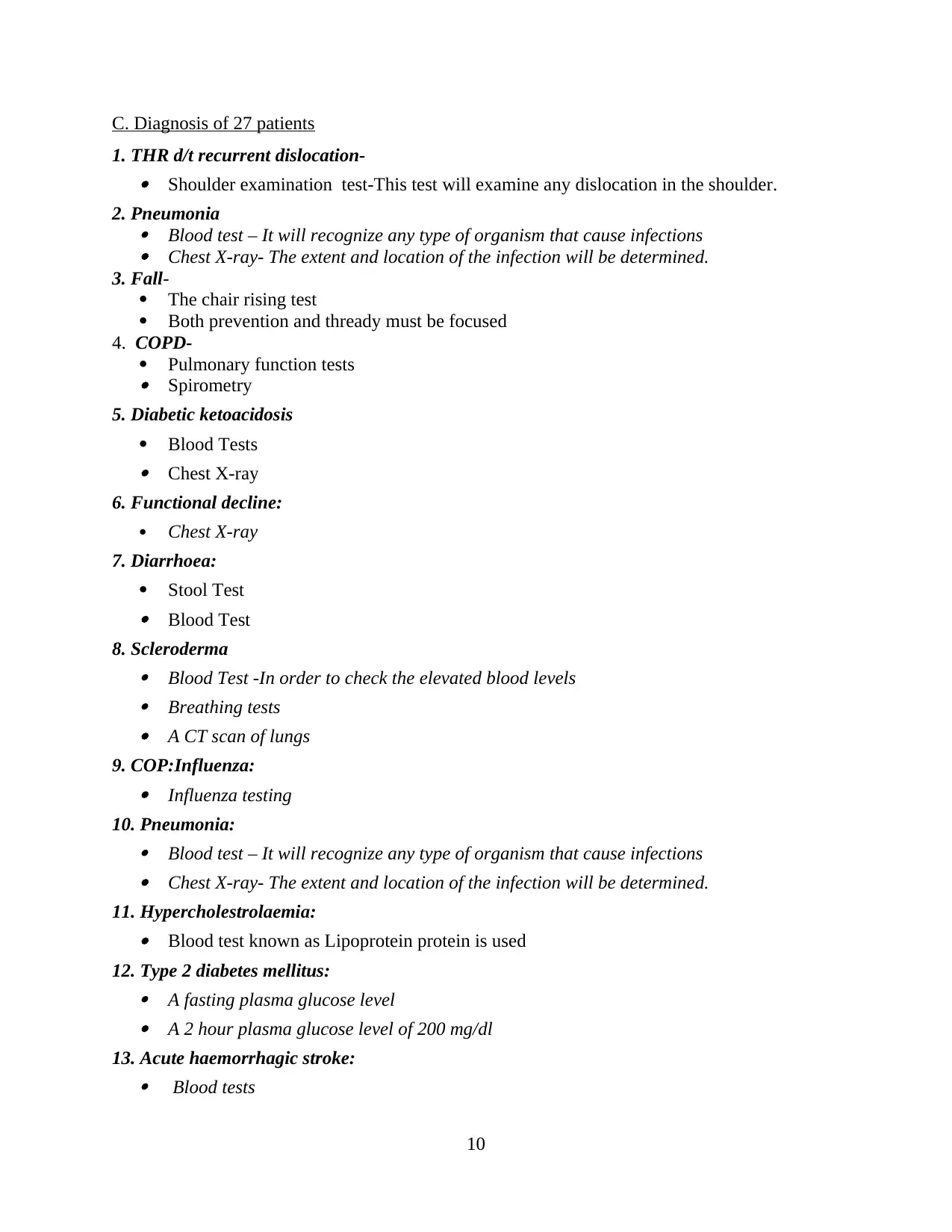
C. Diagnosis of 27 patients
1. THR d/t recurrent dislocation- Shoulder examination test-This test will examine any dislocation in the shoulder.
2. Pneumonia
Blood test – It will recognize any type of organism that cause infections
Chest X-ray- The extent and location of the infection will be determined.
3. Fall-
The chair rising test
Both prevention and thready must be focused
4. COPD-
Pulmonary function tests
Spirometry
5. Diabetic ketoacidosis
Blood Tests Chest X-ray
6. Functional decline:
Chest X-ray
7. Diarrhoea:
Stool Test Blood Test
8. Scleroderma Blood Test -In order to check the elevated blood levels Breathing tests A CT scan of lungs
9. COP:Influenza: Influenza testing
10. Pneumonia: Blood test – It will recognize any type of organism that cause infections Chest X-ray- The extent and location of the infection will be determined.
11. Hypercholestrolaemia: Blood test known as Lipoprotein protein is used
12. Type 2 diabetes mellitus: A fasting plasma glucose level A 2 hour plasma glucose level of 200 mg/dl
13. Acute haemorrhagic stroke: Blood tests
10
1. THR d/t recurrent dislocation- Shoulder examination test-This test will examine any dislocation in the shoulder.
2. Pneumonia
Blood test – It will recognize any type of organism that cause infections
Chest X-ray- The extent and location of the infection will be determined.
3. Fall-
The chair rising test
Both prevention and thready must be focused
4. COPD-
Pulmonary function tests
Spirometry
5. Diabetic ketoacidosis
Blood Tests Chest X-ray
6. Functional decline:
Chest X-ray
7. Diarrhoea:
Stool Test Blood Test
8. Scleroderma Blood Test -In order to check the elevated blood levels Breathing tests A CT scan of lungs
9. COP:Influenza: Influenza testing
10. Pneumonia: Blood test – It will recognize any type of organism that cause infections Chest X-ray- The extent and location of the infection will be determined.
11. Hypercholestrolaemia: Blood test known as Lipoprotein protein is used
12. Type 2 diabetes mellitus: A fasting plasma glucose level A 2 hour plasma glucose level of 200 mg/dl
13. Acute haemorrhagic stroke: Blood tests
10
⊘ This is a preview!⊘
Do you want full access?
Subscribe today to unlock all pages.

Trusted by 1+ million students worldwide
1 out of 25
Related Documents
Your All-in-One AI-Powered Toolkit for Academic Success.
+13062052269
info@desklib.com
Available 24*7 on WhatsApp / Email
![[object Object]](/_next/static/media/star-bottom.7253800d.svg)
Unlock your academic potential
Copyright © 2020–2025 A2Z Services. All Rights Reserved. Developed and managed by ZUCOL.





